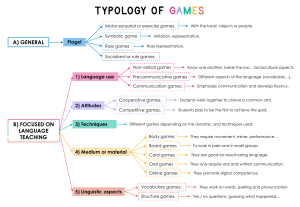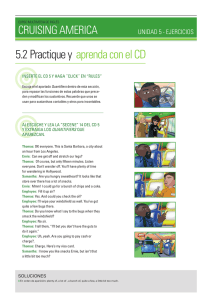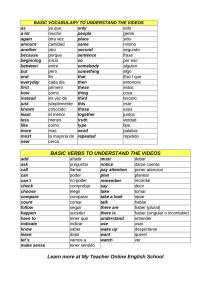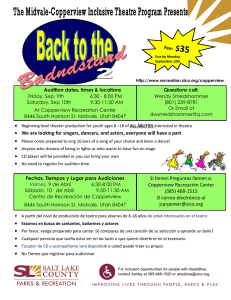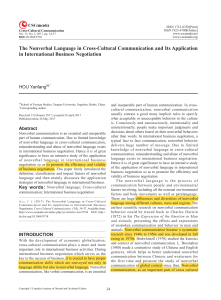IO-5007 Non-Verbal Communication (Body Language / Taller de
Anuncio
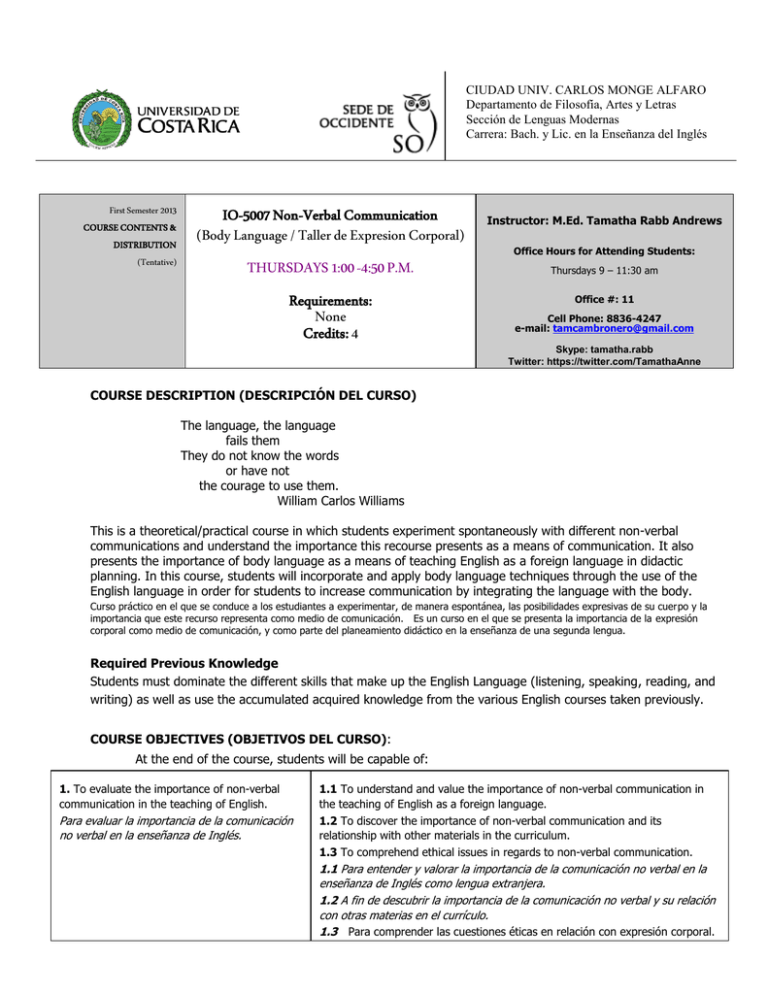
CIUDAD UNIV. CARLOS MONGE ALFARO Departamento de Filosofía, Artes y Letras Sección de Lenguas Modernas Carrera: Bach. y Lic. en la Enseñanza del Inglés First Semester 2013 COURSE CONTENTS & DISTRIBUTION (Tentative) IO-5007 Non-Verbal Communication (Body Language / Taller de Expresion Corporal) THURSDAYS 1:00 -4:50 P.M. Requirements: None Credits: 4 Instructor: M.Ed. Tamatha Rabb Andrews Office Hours for Attending Students: Thursdays 9 – 11:30 am Office #: 11 Cell Phone: 8836-4247 e-mail: [email protected] Skype: tamatha.rabb Twitter: https://twitter.com/TamathaAnne COURSE DESCRIPTION (DESCRIPCIÓN DEL CURSO) The language, the language fails them They do not know the words or have not the courage to use them. William Carlos Williams This is a theoretical/practical course in which students experiment spontaneously with different non-verbal communications and understand the importance this recourse presents as a means of communication. It also presents the importance of body language as a means of teaching English as a foreign language in didactic planning. In this course, students will incorporate and apply body language techniques through the use of the English language in order for students to increase communication by integrating the language with the body. Curso práctico en el que se conduce a los estudiantes a experimentar, de manera espontánea, las posibilidades expresivas de su cuerpo y la importancia que este recurso representa como medio de comunicación. Es un curso en el que se presenta la importancia de la expresión corporal como medio de comunicación, y como parte del planeamiento didáctico en la enseñanza de una segunda lengua. Required Previous Knowledge Students must dominate the different skills that make up the English Language (listening, speaking, reading, and writing) as well as use the accumulated acquired knowledge from the various English courses taken previously. COURSE OBJECTIVES (OBJETIVOS DEL CURSO): At the end of the course, students will be capable of: 1. To evaluate the importance of non-verbal communication in the teaching of English. Para evaluar la importancia de la comunicación no verbal en la enseñanza de Inglés. 1.1 To understand and value the importance of non-verbal communication in the teaching of English as a foreign language. 1.2 To discover the importance of non-verbal communication and its relationship with other materials in the curriculum. 1.3 To comprehend ethical issues in regards to non-verbal communication. 1.1 Para entender y valorar la importancia de la comunicación no verbal en la enseñanza de Inglés como lengua extranjera. 1.2 A fin de descubrir la importancia de la comunicación no verbal y su relación con otras materias en el currículo. 1.3 Para comprender las cuestiones éticas en relación con expresión corporal. 2. To dominate basic body language expressions and communication skills through movement and the voice. Dominar destrezas básicas de expresión y comunicación mediante el movimiento y la voz. 2.1 To develop techniques in non-verbal communication in order for the teacher to emit self-confidence in front of his/her students. 2.2 To recognize and use different types of non-verbal communication techniques as a way of improving one’s ability in this discipline, hence, in order to apply them to different learning/teaching situations. 2.3 To offer students the possibility to work toward their own learning through non-verbal communication, as a means of enriching students’ communication. 2.1 Con el fin de desarrollar técnicas de comunicación no verbal para que el profesor a emitir la confianza en sí mismo delante de sus alumnos. 2.2 Para reconocer y utilizar distintos tipos de comunicación no verbal técnicas como una manera de mejorar la capacidad en esta disciplina, por lo tanto, con el fin de aplicarlos a diferentes aprendizaje / enseñanza de las situaciones. 2.3 Para ofrecer a los estudiantes la posibilidad de trabajar hacia su propio aprendizaje a través de la comunicación no verbal, como un medio de enriquecer los estudiantes comunicación. 3. To determine the importance of movements in didactic planning. Conocer la importancia del planeamiento didáctico por medio del movimiento y el lenguaje corporal. 3.1 To reach a physical mastery in controlling the body in order to protect the teaching/learning environment. 3.2 To plan activities using non-verbal communication in teaching students English in primary and secondary schools. 3.1 Para llegar a un dominio en el control físico del cuerpo a fin de proteger el entorno de enseñanza y aprendizaje. 3.2 Para las actividades del plan mediante la comunicación no verbal en la enseñanza de estudiantes de Inglés en escuelas primarias y secundarias. 4. To have a clear understanding of the importance of a teacher’s personal appearance in front of a class, as a determining factor to obtain attention and concentration in the classroom. 4.1 To emphasize the importance of the teacher's personal presentation in front of a class. 4.2 To highlight the importance of selecting the appropriate apparel and accessories, in order for the teacher to project what he or she had intended and be perceived by his/her students accordingly. Para tener una comprensión clara de la importancia de un maestro personal en el frente de una clase, como un factor determinante para obtener atención y concentración en el aula. 4.1 Insistir en la importancia de que el profesor’s presentación personal en frente de una clase. 4.2 Para poner de relieve la importancia de la selección de las prendas de vestir y accesorios, a fin de que el proyecto maestro que lo que él o ella había tenido la intención y ser percibidos por sus alumnos en consecuencia. 5. To associate non-verbal communication techniques with topics and techniques in which to develop the teaching of English as a foreign language. 5.1 To organize, create, select, and elaborate materials in order to teach the five fundamental skills (listening, speaking, reading, writing and culture) in the teaching of English. Asociar a la comunicación no verbal con las técnicas de temas y técnicas en el que desarrollar la enseñanza del Inglés como lengua extranjera. 5.1 Para organizar, crear, seleccionar y elaborar los materiales con el fin de enseñar las cinco habilidades fundamentales (escuchar, hablar, leer, escribir y la cultura) en la enseñanza de Inglés. COURSE CONTENTS (CONTENIDOS) / LINGUISTIC CONTENTS (CONTENIDOS LINGUíSTICOS) : 1. Non-Verbal Communication in Didactic Planning 2. Understanding the Basics of Non-Verbal Communication 3. Eye Signals 4. The Magic of Facial Expressions 5. The Use of Hands and Arms in Non-Verbal Communication 6. The Use of Legs in Non-Verbal Communication 7. Olfactory Communication 8. Territory, Time, Space, & Distance 9. The Role of Body Language in Interviews 10. Deceit in Non-Verbal Communication 11. Non-Verbal Communication in the Classroom 12. 13. 14. 15. The Codes of Culture Most Common Gestures Found Today Communicating Warmth Ethics Issues in Regards to Non-Verbal Communication TEACHING METHODOLOGY The instructor will present introductory material and will guide the students in commentaries, discussions, and analysis of the assigned readings. Student preparation for and participation in class is vital. Students will engage in non-verbal communication exercises using theory and practice to educate, control and execute the voice, as well as put into practice non-verbal communication techniques developed in each class session. NOTE: This is a workshop in which attendance is mandatory. Any absence must be justified with a certified doctor’s note. El instructor presentará material de introducción y guía a los estudiantes en los comentarios, discusiones y análisis de las lecturas asignadas. Estudiante y la preparación para la participación en clase es fundamental. Los estudiantes participarán en la comunicación no verbal utilizando ejercicios de teoría y la práctica de educar, controlar y ejecutar la voz, así como poner en práctica la comunicación no verbal técnicas desarrolladas en cada período de sesiones de clase. NOTA: Este es un taller en el que la asistencia es obligatoria. Toda ausencia debe justificarse con un certificado médico de la nota. COURSE CONTENTS AND DISTRIBUTION: Session 1 Date 3/14 Content Student Presentations/ Due Dates Read: (1) The Myth of Body Language Pp. 1-12 (2) Unraveling the Mysteries of Body Language Pp. 13-26 (3) Oblivious Actions: The Unconscious Cues of Body Language Pp. 27-36 (4) Understanding the Basics Pp. 7-30 Ice Breaker Introduction to course: discussion of syllabus 2 3/21 3 3/28 Understanding the Basics of Non-Verbal Communication Group Presentation #1 (3 people) Easter Week (No Classes) 4 4/4 5 4/11 Eye Signals The Magic of Facial Expressions Group Presentation #2 (2 people) Present Listening Activity #1 Group Presentation #3 (2 people) Juan Santa Maria Day 6 4/18 The Use of Hands & Arms in Non-Verbal Communication Assignments Present Listening Activity #2 Group Presentation #4 (3 people) Read: (1) The Eyes Have It Pp. 37-50 (2) Eye Signals Pp. 165-191 Read: (1) Our Fabulous Faces Pp. 51-66 (2) The Magic of Smiles & Laughter Pp. 66 - 89 Read: (1) Nice Gestures: Communicating with Your Hands & Arms Pp. 79-90 (2) The Power is in Your Hands Pp. 31-65 Read: (1) Arm Signals Pp. 90-106 (2) Hand & Thumb Gestures Pp. 125-141 (1) Portable Positions: Walking, Sitting & Standing Pp. 91-102 (2) How the Legs Reveal What the Mind Wants to Do Pp. 209-228 7 4/25 8 5/2 The Use of Legs in Non-Verbal Communication Present Speaking Activity #1 Group Presentation #5 (2 people) Read: (1) Nose, Nose, Anything Goes: Olfactory Communication Pp. 103-112 (2) Space & Time Relations: Communicating via Territory, Time & Distance Pp. 113-124 9 5/9 Olfactory Communication Present Speaking Activity #2 Group Presentation #6 (1 person) Read: (1) Space Invaders Pp. 192-208 (2) Ownership, Territory & Height Signals Pp. 317-329 10 5/16 Territory, Time, Space & Distance Group Presentation #7 (2 people) Read: (1) Postures of Power Pp. 125-140 (2) Interviews, Power Plays & Office Politics Pp. 346-363 (3) Interviewing Intelligently: The Role of Body Language Pp. 227-238 11 5/23 The Role of Body Language in Interviews Present Reading Activity #1 Group Presentation #8 (2 people) Read: (1) Cues that Conceal & Reveal: Nonverbal Deception Detection Pp. 141-152 (2) Evaluation & Deceit Signals Pp. 142-164 (3) Fleshing Out Feelings: Emotional Communication Pp. 153-166 12 5/30 Deceit in Non-Verbal Communication Present Reading Activity #2 Group Presentation #9 (2 people) Read: (1) Adolescent Actions: Interacting with Teens Pp. 181-190 (2) Classroom Cues: Body Language in Education Pp. 273-284 13 6/6 Non-Verbal Communication in the Classroom Present Writing Activity #1 Group Presentation #10 (1 person) Read: (1) The Codes of Culture: Recognizing & Transcending Diversity Pp. 317-330 UCR Student Body Week (Semana Universitaria) Read: (1) How the Body Points to Where the Mind Wants to Go Pp. 279-285 (2) Seating Arrangements Pp. 330-345 (2) Cultural Differences Pp 107-124 14 6/13 The Codes of Culture Present Writing Activity #2 Group Presentation #11 (1 person) Read: (1) Silent Messages in the Workplace Pp. 239-252 (2) The Secret Signals of Cigarettes, Glasses & Makeup Pp. 265-278 (3) The Thirteen Most Common Gestures Youll See Daily Pp. 229-249 15 6/20 Most Common Gestures Found Today Present Culture Activity #1 Group Presentation #12 (2 people) Read: (1) Digital Communication: Reach Out & Touch Someone Pp. 67-78(2) Closeness Counts: Communicating Warmth Pp. 191-204 (3) Mirroring How We Build Rapport Pp. 250-264 16 6/27 Communicating Warmth Present Culture Activity #2 Group Presentation #13 Read: (1) Putting It All Together Pp. 364-379 (2 people) 17 7/4 Wrapping up the course. 18 7/11 Grades will be posted outside my office Turn in the completed final project. Turn in Final Projects by 1:30 pm Congratulations to the upcoming graduates! Note: Slight changes may occur in the COURSE CONTENTS AND DISTRIBUTION. You are responsible to take note(s) of these changes as they occur. EVALUATION: COMPONENTS PERCENTAGES Group / Individual Presentation 10% (9) Pop Quizzes @ 5% each Final Project / Activity Booklet Twitter Feedback 45% 40% 5% Description of the Course Assignments: Group / Individual Presentation: Ss. will present the reading selections on non-verbal communication in groups or individually. (First come. . . first serve on your choice of topics.) Students should take into account the material when presenting and create a problem solving activity to check the groups understanding of the selection as well as create a summary of the material for each student. Be creative and use technology wherever possible. You have approximately 40 min. of class time for this presentation. Quizzes: Pop quizzes will be given throughout the semester. A total of ten quizzes will be applied. At the end of the course, the lowest quiz grade will be dropped, which will give a total of nine quizzes in the end at 5% each. These short tests consists of two to five questions which will be dictated at any time during the class session. Anyone who is not present without a written excuse will automatically obtain a zero for said quiz. It is recommended that on the occasion a student is unable to attend a class session: (1) the student should inform the professor of the situation prior to the class session and (2) bring a written excuse to class within a week of the absence. Twitter Feedback: As this course is a workshop on non-verbal communication, we will be adding a 5% feedback using Twitter messaging. These comments and suggestions should be focused primarily on group presentations related to the final project starting on April 11th. Each student must post at least 5 comments minimum, at 1% each, on said mini skills presentations. Note: there is no maximum number of Twitter posts, so comment as much as you like during the class presentations but giving yourself time to be actively involved in the presentors’ activities. Keep in mind to use good ethics in not abusing the use of texting, whether it be by phone, tablet, or by computer. The use of these devices previously mentioned are for the soul purpose of giving Twitter comments concerning non-verbal communication. These comments are to be made at https://twitter.com/TamathaAnne Final Project: The aim of the project is twofold. On the one hand, it is designed to help you synthesize your knowledge of the reading selections on non-verbal communicaiton. On the other hand, it provides a means for you to monitor your understanding of the material via putting it into practice by showing how body language can be used to teach/learn English. Throughout this semester, you will be asked to create two original didactic activities to teach each of the five skills (listening, speaking, reading, writing and culture) for the grade level of your choice. Activities will be presented to the class on the days specified in the COURSE CONTENTS section of this syllabus. You are encouraged to create an activity booklet that you will actually use in either your present or a future teaching environment. (See the Grading Rubric at the end of this syllabus.) GUIDLINES: Include a title page, table of contents, introduction and a bibliography. Your final project should not exceed fifteen (8" x 11") pages and be submitted in a typed format, double-spaced. The photocopiable handouts you include are not included in the page count and should be placed right after each activity description. You may use single-spacing and other formats for handouts as necessary. Write on only one side of each page. Number every page after the first. Leave one-inch margins on either side of the page for comments. Prepare a one-page overview of the non-verbal communication ideas incorporated in the activity booklet as part of the introduction to your final project. Final projects are due by 1:30pm on July 4th. There are no email options for turning in this project. Projects will not be accepted after the deadline. Ampliacion Exam An Ampliacion Exam will be given to those students who have obtained a 6.0 to a 6.5. If the student passes this exam, the final grade will be a 7.0. This exam covers all of the course readings and lectures. Bibliography Anderson, Peter. (2004). The Complete Idiot’s Guide to Body Language. Alpha Books, New York. Freeman, Gaylene. (2005). Acting Antics - Theatre Games, Drills, & Exercises for the Classroom. Teacher’s Discovery, USA. Moore, Lisa and Eva White. (2005). Utilizing Games and Cooperative Learning Activities in the Classroom. Teacher’s Discovery, USA. Pease, Barbara and Allan. (2006). The Definitive Book of Body Language. Bantam, USA. Pease, Barbara and Allan (2005). The Definitive Book of Body Language [Audiobook] (Audio CD). Orion, UK. Quilliam, Susan. (2004). Body Language. Firefly Books, USA. Materials compiled by the professor. Required Items Prepared Anthology (Chapters from Barbara & Allan Pease as well as Anderson) As this course will be implementing the use of Twitter during class for comments and suggests to other group projects, students are encouraged to create a Twitter account as soon as possible and to bring either their laptop or internet accessable cell phone to class. Course Policies - Reading assignments must be completed before the class under which they are indicated in the Schedule of Reading Topics of this syllabus. -Please note that university rules clearly and emphatically stipulate that all cell phones must be turned off during class. The exception being when we are doing group presentations which involves Twitter comments and suggestions during said presentations. Ethics Issues in Regards to Non-Verbal Communication Nonverbals are an important component of communication. They help you interpret and understand verbal messages and, in doing so, help you more effectively navigate your everyday life. Studying nonverbals is particularly important because they are complex and ambiguous. Without sufficient understanding of how the various nonverbal codes work together in specific contexts, cultures, and relationships, one can easily misunderstand others’ nonverbal messages or assume meaning where none exists. Nonverbal communication is defined as all the messages that people transmit through means other than words, and it occurs when nonverbal behavior has symbolic meaning. To understand the meaning of a nonverbal behavior you have to consider the entire behavioral context, including culture, relationship type, background knowledge, and gender. Nonverbal communication occurs through five codes or types of signals: kinesics, paralinguistics (vocal qualities), chronemics (time) and proxemics (space), haptics (touch), and appearance and artifacts. These codes can combine to serve one of five functions, such as communicating information, regulating interaction, expressing and managing intimacy, exerting social control, and performing service-task functions. As we’ve shown, nonverbal communication is not performed in a vacuum; rather, power relationships as well as societal norms and rules influence the range of nonverbal behaviors we are allowed to perform and how those behaviors are interpreted. In addition, everyone needs to be aware that nonverbal communication can trigger and express prejudice and discrimination. Thus nonverbal communication has ethical aspects. Ethical considerations for nonverbal communication involve nonverbal “deception” and nonverbal behaviors that ridicule, derogate, or otherwise demean others. You can become more effective in interpreting others’ nonverbal communication by assessing the congruence of the verbal and nonverbal components of a message; analyzing the context, your knowledge of the other person, and your own experiences; recognizing that others’ nonverbal messages don’t always mean the same as yours do; asking for additional information if you don’t understand a nonverbal message; and remembering that not every nonverbal behavior is intended to be communicative.
